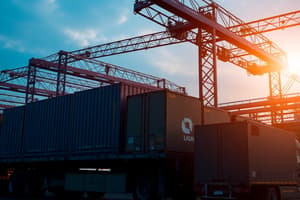Podcast
Questions and Answers
What does Supplier Relationship Management (SRM) primarily encompass?
What does Supplier Relationship Management (SRM) primarily encompass?
- All processes within a firm's internal logistics department.
- The management of a firm's internal research and development.
- All financial transactions between a firm and its shareholders.
- All processes at the interface between the firm and its suppliers. (correct)
Why does Zara source products with uncertain demand from local manufacturers?
Why does Zara source products with uncertain demand from local manufacturers?
- To take advantage of lower labor costs in local regions.
- To create a supply chain that has a long lead-time.
- To reduce shipping costs regardless of demand.
- To enable a rapid response to changing trends and demand. (correct)
What advantage does Zara gain by replenishing its stores multiple times a week?
What advantage does Zara gain by replenishing its stores multiple times a week?
- Minimizing stockouts while reducing inventory. (correct)
- Simplifying overall supply chain complexity.
- Having less need to use data and logistics.
- Lowering overall transportation expenses.
According to the discussion, what is a primary reason for Amazon to build more warehouses?
According to the discussion, what is a primary reason for Amazon to build more warehouses?
What benefits can online retailers gain by establishing physical brick-and-mortar stores?
What benefits can online retailers gain by establishing physical brick-and-mortar stores?
How should store inventories be managed in an omni-channel setting?
How should store inventories be managed in an omni-channel setting?
What skills have employers identified as critical and that can be developed from supply chain discussions?
What skills have employers identified as critical and that can be developed from supply chain discussions?
Why does Inditex (Zara's parent company) maintain manufacturing capacity in Europe despite cheaper options in Asia?
Why does Inditex (Zara's parent company) maintain manufacturing capacity in Europe despite cheaper options in Asia?
What entities are included in a supply chain?
What entities are included in a supply chain?
What does the term 'supply chain surplus' refer to?
What does the term 'supply chain surplus' refer to?
Why might it be more accurate to refer to a supply chain as a 'supply network'?
Why might it be more accurate to refer to a supply chain as a 'supply network'?
What is the primary objective of a supply chain?
What is the primary objective of a supply chain?
Which of the following is NOT a component of supply chain flows?
Which of the following is NOT a component of supply chain flows?
How should success in a supply chain be measured?
How should success in a supply chain be measured?
Which function is NOT typically involved in fulfilling a customer request within a supply chain?
Which function is NOT typically involved in fulfilling a customer request within a supply chain?
What does the term 'supply chain profitability' refer to?
What does the term 'supply chain profitability' refer to?
What primarily determines supply chain profitability?
What primarily determines supply chain profitability?
What is one of the main goals of supply chain planning?
What is one of the main goals of supply chain planning?
Which phase of the supply chain focuses on daily operational decisions?
Which phase of the supply chain focuses on daily operational decisions?
What are push processes initiated by?
What are push processes initiated by?
In the cycle view of supply chain processes, what do processes typically represent?
In the cycle view of supply chain processes, what do processes typically represent?
What does effective supply chain management involve?
What does effective supply chain management involve?
Which of the following sentences correctly describes supply chain design decisions?
Which of the following sentences correctly describes supply chain design decisions?
Which company is an example of significant growth attributed to successful supply chain decisions?
Which company is an example of significant growth attributed to successful supply chain decisions?
In the push/pull view, what distinguishes push processes from pull processes?
In the push/pull view, what distinguishes push processes from pull processes?
What defines customer relationship management (CRM) processes in the supply chain?
What defines customer relationship management (CRM) processes in the supply chain?
What is a defining characteristic of supply chain operations?
What is a defining characteristic of supply chain operations?
Why is supply chain strategy important?
Why is supply chain strategy important?
What must supply chain planning consider during its decision-making?
What must supply chain planning consider during its decision-making?
Flashcards
What is a Supply Chain?
What is a Supply Chain?
A network of organizations and individuals involved in the process of fulfilling a customer's request, from raw materials to the final product.
What is a Supply Chain?(2 of 3)
What is a Supply Chain?(2 of 3)
The customer is a crucial part of the supply chain, not just an end point. It also includes the flow of information, funds, and products in both directions.
Objective of a Supply Chain
Objective of a Supply Chain
The primary goal is to maximize the net value generated for all parties involved. This is calculated by subtracting the total cost from the customer value received.
Supply Chain Surplus
Supply Chain Surplus
Signup and view all the flashcards
Measuring Supply Chain Success
Measuring Supply Chain Success
Signup and view all the flashcards
Flows in a Supply Chain
Flows in a Supply Chain
Signup and view all the flashcards
Supply Network
Supply Network
Signup and view all the flashcards
Typical Supply Chain Stages
Typical Supply Chain Stages
Signup and view all the flashcards
What is Supplier Relationship Management (SRM)?
What is Supplier Relationship Management (SRM)?
Signup and view all the flashcards
How does Zara's responsive supply chain benefit the company?
How does Zara's responsive supply chain benefit the company?
Signup and view all the flashcards
Why does Inditex use both in-house and outsourced manufacturing?
Why does Inditex use both in-house and outsourced manufacturing?
Signup and view all the flashcards
Why does Zara source some products locally and others from Asia?
Why does Zara source some products locally and others from Asia?
Signup and view all the flashcards
What is the benefit of Zara's frequent store replenishment?
What is the benefit of Zara's frequent store replenishment?
Signup and view all the flashcards
Why does Amazon build more warehouses as it grows?
Why does Amazon build more warehouses as it grows?
Signup and view all the flashcards
What benefits do brick-and-mortar stores offer online retailers?
What benefits do brick-and-mortar stores offer online retailers?
Signup and view all the flashcards
Why does the online channel have an advantage for selling shoes and diapers compared to retail stores?
Why does the online channel have an advantage for selling shoes and diapers compared to retail stores?
Signup and view all the flashcards
Supply chain profitability
Supply chain profitability
Signup and view all the flashcards
Decision Phases in a Supply Chain
Decision Phases in a Supply Chain
Signup and view all the flashcards
Supply Chain Strategy or Design
Supply Chain Strategy or Design
Signup and view all the flashcards
Strategic Supply Chain Decisions
Strategic Supply Chain Decisions
Signup and view all the flashcards
Supply Chain Planning
Supply Chain Planning
Signup and view all the flashcards
Planning Decisions
Planning Decisions
Signup and view all the flashcards
Supply Chain Operation
Supply Chain Operation
Signup and view all the flashcards
Operational Decisions
Operational Decisions
Signup and view all the flashcards
Cycle View
Cycle View
Signup and view all the flashcards
Push/Pull view
Push/Pull view
Signup and view all the flashcards
Push/Pull Boundary
Push/Pull Boundary
Signup and view all the flashcards
Customer Relationship Management (CRM)
Customer Relationship Management (CRM)
Signup and view all the flashcards
Internal Supply Chain Management (ISCM)
Internal Supply Chain Management (ISCM)
Signup and view all the flashcards
Supply Chain Processes
Supply Chain Processes
Signup and view all the flashcards
Study Notes
Supply Chain Management Overview
- A supply chain encompasses all parties involved, directly or indirectly, in fulfilling a customer request.
- This includes manufacturers, suppliers, transporters, warehouses, retailers, and customers.
- Internally, all functions involved in receiving and fulfilling a customer request are part of the supply chain (e.g., new product development, marketing, operations, distribution, finance, customer service).
- The customer is a crucial element of the supply chain.
- The supply chain involves the flow of products (from suppliers to manufacturers to distributors), information, funds, and products in both directions.
- "Supply network" or "supply web" can also accurately describe the interlinked relationships.
- Typical supply chain stages include customers, retailers, wholesalers, distributors, manufacturers, and suppliers.
Supply Chain Objective
- The goal is to maximize the "supply chain surplus."
- Supply Chain Surplus = Customer Value − Supply Chain Cost
- For example, if a customer buys a router for $60, the supply chain's total cost must be lower than this revenue.
- Supply chain profitability is the cumulative profit shared across all supply chain stages.
- Success is assessed by total supply chain surplus, not individual stage profits.
- Customer requests are the sole source of revenue.
- Costs are incurred throughout the supply chain, including information transfer, production, storage, transportation, and funds transfer.
- Effective supply chain management improves supply chain surplus by managing assets and flows of products, information, and funds.
Supply Chain Importance
- The success of significant companies illustrates different outcomes based on effective or ineffective supply chain management.
- Examples include Wal-Mart's growth from $1 billion to $482 billion in sales, contrasted with Webvan's failure within two years.
Decision Phases in Supply Chains
- A supply chain strategy or design focuses on long-term configuration and resource allocation over several years.
- Supply chain planning governs short-term operations, lasting a quarter or year, and aims to maximize surplus given existing constraints.
- Supply chain operations manage daily or weekly operational decisions for individual customer orders. Factors to address include allocation, due dates, pick lists, shipment/delivery scheduling, and replenishment orders.
Process Views of a Supply Chain
- The Cycle View structures processes into a series of cycles at the interfaces between supply chain stages.
- The Push/Pull View divides processes into those responding (pull) to customer orders and those performed in anticipation of orders (push). The push/pull boundary distinguishes these two types of processes.
Zara's Approach
- Zara's highly responsive supply chain offers advantages over competitors.
- Zara balances in-house and outsourced manufacturing, maintaining European production capacity to cater to its responsive model.
- Zara sources uncertain-demand items from local manufacturers and predictable-demand items from Asia.
- Frequent replenishment of store inventory offers quicker availability of new products.
- This replenishment method prioritizes retail sales over exclusively online sales.
Amazon's Approach
- Amazons warehouse strategy is related to growth.
- Decisions on warehouse quantity and location need optimization.
- Stock management, including whether to stock every product or focus on a smaller selection, is a key decision.
- Combining online and brick-and-mortar locations is an area of exploration for maximum sales advantage.
- Online channel benefits and potential drawbacks in selling particular products like shoes and diapers, relative to retail stores, differ greatly based on demand patterns.
Macy's and W.W. Grainger Approaches
- The best location for fulfilling online orders (stores versus fulfillment centers) is determined by several factors.
- Store inventory management in an omni-channel setting requires balancing online orders with store sales.
- The handling of returned merchandise might involve storing returns in stores or having a dedicated return center.
Studying That Suits You
Use AI to generate personalized quizzes and flashcards to suit your learning preferences.



